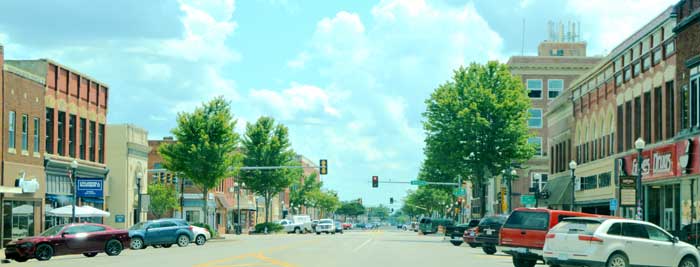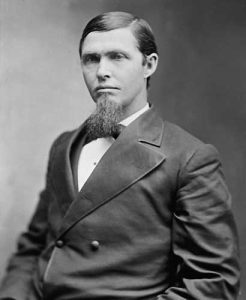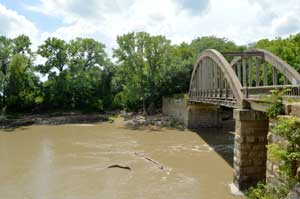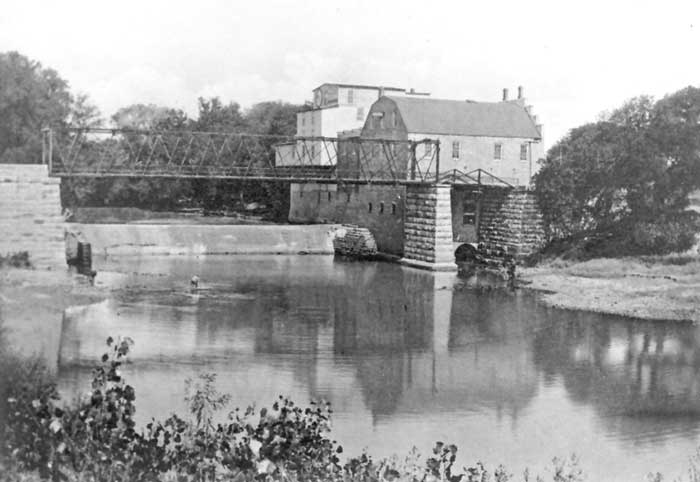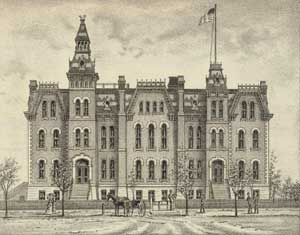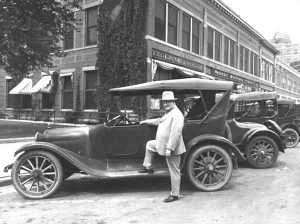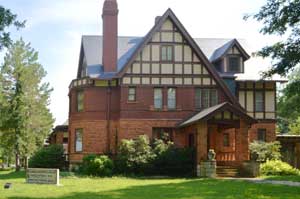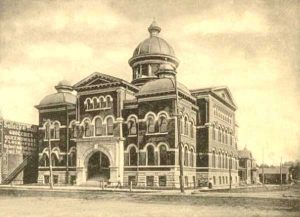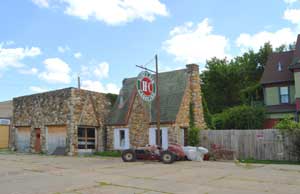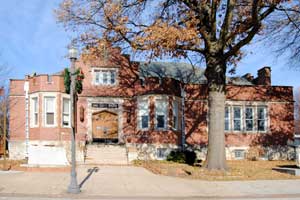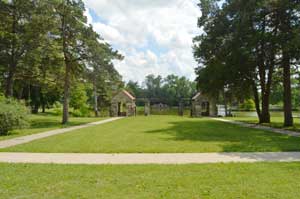Emporia – Hub of East Central Kansas – Legends of Kansas (original) (raw)
Commercial Street, Emporia, Kansas by Kathy Alexander.
Emporia, Kansas, is the county seat of Lyon County and one of the state’s principal cities, and it is located near the center of the county. Situated just six miles above the junction of the Neosho and Cottonwood Rivers, it sits in the geographic area called the Osage Cuestas in north-central Kansas.
Emporia was founded on February 20, 1857, and located on an upland prairie, drawing its name from a historic Greek market center. When the Kansas Territorial Legislature ratified the town charter for Emporia, it declared it “the loveliest site in the world for a town.” When the city was founded, it was part of Breckinridge County, which was formed in 1855 and named for John C. Breckenridge, a military man who was elected Vice-President of the United States in 1857.
Preston B. Plumb.
The principal founder and promoter of the settlement was a man named Preston B. Plumb. Although a young man at the time – only 20 years old, Plumb, originally from Ohio, was ambitious. After founding Emporia, he would go on to be admitted to the bar, serve in the Civil War, become a Kansas House of Representatives member, and a U.S. Senator. Other interested parties in founding the new settlement were George W. Deitzler, G.W. Brown, Lyman Allen, and Columbus Hornsby, all of Lawrence. C. V. Eskridge was appointed as the agent of the townsite company to sell its property and look after its general business interests.
The town charter prohibited gambling and liquor sales, the penalty being the forfeiture of the property on which the misdemeanor occurred. Thus, Emporia’s founders established the first prohibition town in the world, anticipating by 23 years the state prohibition amendment and by 61 years the 18th Amendment bringing national prohibition.
The first building was a 1 ½ story wooden boarding house erected by John Hammond. Before long, Mr. and Mrs. T. H. Clapp from New York came to town. Hammond hired Mrs. Clapp, the first woman in the settlement, to cook for him. Within no time, the boarding house was crowded to its utmost capacity. The building was also used for religious services and educational purposes, as well as for county headquarters and a broker’s office.
The second building was the store of Hornsby & Fick. Townsite agent C. V. Eskridge, who would eventually own it, worked as a clerk in the store.
The next building completed was the Emporia House, the town company’s hotel. John Hammond, who owned the boarding house, first operated it, but, after running it for a few months, resigned in favor of Mrs. Elizabeth Storrs, who, therefore, may be considered the first regular land-lady of Emporia. In the meantime, the News building was not yet completed, and the Emporia House also served as the newspaper’s temporary printing office. Town founder Preston B. Plumb published the first edition of the Kanzas News, later the Emporia News, on June 6, 1857, from an upstairs room. In its first edition, the newspaper provided this description of fledgling town:
Cottonwood River, Emporia, Kansas by Kathy Alexander.
“Emporia is situated between the Neosho and Cottonwood creeks, six miles above their junction. To the west, it gradually rises for a distance of several miles. On the north and south are large belts of the finest timber along the Neosho and Cottonwood Rivers, while the various smaller streams emptying into them at this point, all well-timbered, serve to make it one of the best-timbered regions in Kansas. Coal and building stone are found here in abundance. Emporia was located in March last. About the first of April, the erection of a large hotel was commenced by the town company, which has just been completed. A commodious storehouse has just been erected and filled with goods; another is in the erection process. A large saw and gristmill, with lath and shingle machines attached, is being put up on the townsite. Another large sawmill is in the process of construction one-half a mile distant. There is, at present, one saw-mill in operation near the junction, six miles distant, which has furnished the lumber used in the erection of the buildings now on the townsite. There is also another saw-mill eight miles above, on the Cottonwood River, which is in operation.”
When the News building was completed, it became the 4th building on the townsite. It served the newspaper for 14 years before the building began to be utilized for several other purposes, including as a residence, the post office, a bank, a furniture factory, a city hall, a church, and a hardware store.
The Soden Flour Mill on the Cottonwood River was one of the early businesses of Emporia. The two-story structure was built in 1860 by William T. Soden. Unfortunately, it burned to the ground in the 1930s.
Founder and newspaperman Preston B. Plumb would state in his paper: “The country around here is fast filling up with an energetic, industrious and intelligent population who will develop the rich resources of this fertile region and make it the center of wealth and intelligence.” Jacob Stotler, the print foreman for Plumb’s Kanzas News, credited the newspaper with much of the town’s early growth and development. The news not only provided information, but it served the role of an early-day chamber of commerce.
“We do not exaggerate when we say that the regular appearance of The News during the first year of the history of Emporia did more to save the town and establish its firmness in the confidence of the people than all else put together,” Stotler wrote. “It betokened a faith and purpose which put down the croakers who prophesied that the town would fail. It inspired confidence in those already here, and induced others to come. Its suspension, even temporarily, would have resulted disastrously for the town, and its combined regular publication during that year was the greatest pecuniary sacrifice that has been made for the benefit of Emporia and this surrounding country.”
Early day Emporia, Kansas.
The town company encouraged improvement by setting aside several lots for those who would put up buildings on them. Mr. Parham, a druggist from Leavenworth, Kansas, and Mr. Phelps, a Michigan man, built a sawmill among the new arrivals.
Despite the area’s fast growth that first year, Emporia’s actual population was only about 540 people. The town’s two greatest needs were water and railroads. Water was carried from the Cottonwood River in barrels during the first year.
In the summer of 1857, railroad matters, religious matters, educational topics, a lack of water, and mail troubles all agitated young Emporia. The Baptists and Methodists held services in the old hotel office. Mail facilities were abominable, and the citizens of Emporia insisted on having a school. The third public meeting ever held in the town was a railroad convention that assembled in June.
The first issue to be resolved was the mail. Because a post office had already been established at Columbia, three miles southeast of Emporia on the Cottonwood River, the government refused to favor one for Emporia because the other was so close. However, when Columbia postmaster John Fowler resigned, the post office was moved to Emporia on September 19, 1857. Hornsby & Fick store owner, Mr. Fick, became the Emporia’s first postmaster. The issue of schools was resolved when Miss Mary Jane Watson taught the first public school in October 1857.
Kanzas News, Emporia, Kansas.
In April 1858, the Reverend G. C. Morse and his wife opened the Emporia Academy. In the second week of May 1858, the water problem was also resolved when a well saved it. Preston B. Plumb had hired John Hammond to find water. He was successful while digging on Mechanic Street on the site of the present-day civic auditorium. The growth of the town was brisk from the beginning. In the subsequent years before the Civil War, a steady stream of settlers located in the town and the surrounding country established new business enterprises, and several churches were built.
The Kanzas News became the Emporia News in 1858, and Plumb sold half of his interest in the business to his print foreman, Jacob Stotler. The following year, Stotler bought Plumb’s remaining interest in the newspaper as Plumb pursued other political interests.
As 1859 began, the Emporia News congratulated the town on its New Year’s issue on the growth and general prosperity of the city. “All its mechanical shops had plenty to do at good wages, “Stotler wrote. “There were four stores at that time, and they were profitable (the Proctor general merchandise store, the hardware store of Edward Borton, the Fick & Eskridge, and the P.G. Hallberg stores). Several houses were in the course of construction, and seventeen lots had been donated by the town company for new buildings to be erected at once. More than fifty houses would be erected during the season.”
In December 1859, the first school district was organized in Emporia. Its Directors were Colonel F. W. Cloud, C. C. Dodge, and Ed. Borton. In 1862, C. V. Eskridge, then a member of the Kansas Legislature, secured the passage of a special act authorizing Emporia District No. 1 to issue bonds in the amount of $6,000 to erect a school building. The bonds were issued and sold, and with the proceeds thereof, a building was erected, which, at the time, was considered the finest common-school building in the State outside of Leavenworth. Seeing how successfully the plan worked, this special act was made the basis of general school law for the entire state.
Missouri, Kansas & Texas Depot in Emporia, Kansas.
In early 1860, the county-seat location was a major issue. The county seat had been designated as Americus two years earlier, in 1858. Ultimately, Emporia was chosen as the county seat by 155 votes over Americus in February 1860, where it remains today. At that time, there were about 3,500 residents in the county, but that year, the area suffered a severe drought, and many moved eastward. Some relief was provided to those who stayed, but the county would continue to suffer an economic downturn the next year with the breaking out of the Civil War.
On December 22, 1860, the Missouri-Kansas-Texas Railroad reached Emporia, setting the stage for the city to become an important railroad hub. By this time, the city was called home to some 843 people.
During the Civil War, Emporia was one of the towns listed in Confederate General Sterling Price’s itinerary of destruction and would have been sacked and burned, but, if not for the prompt response, all through eastern Kansas to check the invasion. The city soon became a stopping place for the soldiers on their various campaigns against the bushwhackers and Indians during and after the war. With the Civil War in full gear, the county name was changed in February 1862, as the former Vice President Breckenridge had become a secessionist and a high-ranking officer in the Confederate Army. The patriotic anti-slavery legislature changed the name of the county to Lyon in honor of Nathaniel Lyon, the Union general who had lost his life in the Battle of Wilson’s Creek the previous August.
State Normal School in Emporia, Kansas.
In 1863, C. V. Eskridge, as a Kansas Representative, introduced a bill providing for the establishment of a State Normal School at Emporia. The bill was passed, and the state made an endowment of 45,680 acres of land. In February 1864, a Board of Directors was appointed, and an appropriation of 1,000wasmadeforteachers’wages.TheDistrictSchoolBoardofEmporiadonatedtheuseofthesecondstoryoftheoldstoneschoolbuildingforclasses,andthefirsttermwasopenedinFebruary1865with19students.Duringthatyear,anappropriationof1,000 was made for teachers’ wages. The District School Board of Emporia donated the use of the second story of the old stone school building for classes, and the first term was opened in February 1865 with 19 students. During that year, an appropriation of 1,000wasmadeforteachers’wages.TheDistrictSchoolBoardofEmporiadonatedtheuseofthesecondstoryoftheoldstoneschoolbuildingforclasses,andthefirsttermwasopenedinFebruary1865with19students.Duringthatyear,anappropriationof10,000 was made by the Kansas Legislature to erect suitable buildings. In 1866, a stone building was completed on a site of 20 acres. At this time, the school numbered 100 students and employed three Instructors. The general progress of the school during the next five years was so rapid that the building became inadequate. By the fall of 1871, 215 students were enrolled, and the following year, the Legislature appropriated 50,000foranewbuilding,whichwascompletedin1873for50,000 for a new building, which was completed in 1873 for 50,000foranewbuilding,whichwascompletedin1873for68,000.
In the meantime, the first Lyon County courthouse was built in 1866 in Emporia at Third and Commercial for $19,695. It served the community until a second courthouse was built in 1901 at Fourth and Commercial.
In July 1870, the Atchison, Topeka & Santa Fe Railroad arrived in Emporia, and the city became an important railroad center. By this time, the city had continued growing rapidly, boasting a population of 2,168.
1878 was a bad year for the Kansas Normal School. First, a tornado damaged the main building and another smaller building. Then, in October, both the new and old buildings were destroyed by fire, and nothing was saved. The enrollment dropped to just 90 students, and the rebuilding process began again. The following year, the Kansas Legislature appropriated more funds, and work began on a new building, which was completed in May 1880 atop the foundation of the burned building.
William Allen White, owner of the Emporia Gazette.
By this time, the city was flourishing and home to some 4,631 people. It was filled with several beautiful churches and banking institutions noted throughout the State for their substantial and “unfailing” qualities, first-class hotels, and numerous prosperous businesses.
By 1889, the number of students enrolled at the Kansas Normal School (908) was higher than the enrollment at the University of Kansas (508) and Kansas State University (514). The following year, the school became the largest in the state and the largest normal school in the nation.
Through the years, Emporia had several newspapers, including its first, the Kanzas News, followed by the Emporia Republican, Emporia Democrat, and the Emporia Ledger. In 1890, J. R. Graham founded the Emporia Gazette, which would last for the next 100 years and beyond.
William Allen White’s house in Emporia, Kansas is a state historic site, photo by Kathy Alexander.
In 1895, a young 27-year-old named William Allen White borrowed the money and paid $3,000 for the newspaper. After writing for several Kansas publications, White considered purchasing newspapers in several northeast Kansas cities, including Lawrence, but decided on Emporia, the town where he was born and where he had attended college. Playing the role of a small-town country editor, he covered controversial issues in a blunt writing style that set him apart from other journalists of his time. His editorials, often supporting small-town values, were frequently printed in national newspapers and magazines, bringing worldwide recognition to him and the Emporia Gazette.
White continued to gain prominence through his political associations, national writings, and a Pulitzer Prize and became a confidant of Presidents. Today, he is known as one of the greatest journalists ever. Through the years, a Liberty ship and a B-29 Bomber were named for him in WWII, a 3¢ stamp was made in his honor by the U.S. Postal Service in 1948, and the University of Kansas Journalism School was named for him. His home in Emporia is now a Kansas State Historical Site, museum, and National Historic Landmark. The Emporia Gazette continues to operate today by the White family. The newspaper office features a small museum.
Lyon County Courthouse, Emporia, Kansas.
By the turn of the century, Emporia was called home to 8,223 people. In 1901, a second courthouse was built at Fourth and Commercial, which would serve until 1954. In the early 20th century, Emporia had become an important railroad center at the junction of the Missouri-Kansas-Texas Railroad and the main line of the Atchison, Topeka & Santa Fe Railroads. It was the terminus of three branches of the latter system, one running to Holliday, one to Chanute, and the other to Moline. It had waterworks, electricity for lighting and power purposes, police and fire departments, well-paved streets, and a public library. Among the city’s industries were woolen and flour mills, foundries, machine shops, carriage and wagon works, an ice plant, broom factories, a planing mill, a creamery, brick and tile works, a corrugated culvert factory, and marble works. The town also boasted three banks, one daily and two weekly newspapers, an international money order post office with ten rural routes, an opera house, telegraph, and express service, and an important mercantile center. By 1910, the population had grown to 9,058.
Old Sinclair Station in Emporia, Kansas, by Kathy Alexander.
Emporia’s population will continue to grow for the next century, maintaining its diversity as a center for manufacturing, trade, education, medicine, and tourism.
The Kansas Normal School grew through the years, becoming the Kansas State Teachers College in 1923 and changing its name to Emporia State University in 1977. Currently, there are about 6,000 students enrolled.
In 1953, Emporia received national attention again when it became the site of the first Veterans Day observance in the United States. At the urging of local shoe cobbler Alvin J. King, U.S. Representative Edward Rees introduced legislation in The United States Congress to rename Armistice Day as Veterans Day. President Dwight D. Eisenhower signed the bill into law on October 8, 1954. That same year, the city had grown to such an extent that Lyon County needed a new courthouse, which was completed in 1954 at Fourth and Commercial, the same location as the old courthouse.
Lyon County Museum in Emporia, Kansas by Kathy Alexander.
Today, the city is called home to about 24,600 people. Despite a growing business and industry community, the community proudly maintains its small-town charm. Many Victorian homes, tree-lined avenues, and brick streets have been preserved. Thirteen structures within the city are listed on the National Register of Historic Places, including the Old Emporia Public Library, the Granada Theater (also known as the Fox Theater), the Anderson Carnegie Memorial Library, the original homes of Preston B. Plumb and William Allen White House, as well as several other beautiful homes. More information on the history of Emporia can be found at the Lyon County Museum & Historical Society located at 118 E. Sixth Avenue.
Emporia lies between Topeka and Wichita at the intersection of U.S. Route 50 with Interstates 335 and 35 on the Kansas Turnpike.
More Information:
Emporia Chamber of Commerce
719 Commercial St.
Emporia, Kansas 66801
Peter Pan Park in Emporia, Kansas by Kathy Alexander.
620-342-1600 or 800-279-3730
© Kathy Alexander/Legends of Kansas, updated April 2024.
Also See:
